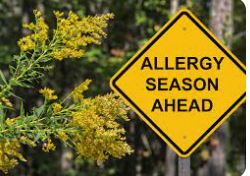 As we approach the allergy season....its helpful to find non-pharmaceutical remedies.
As we approach the allergy season....its helpful to find non-pharmaceutical remedies.
Allergies occur when your immune system reacts to a foreign substance — such as pollen, bee venom or pet dander — or a food that doesn't cause a reaction in most people.
Your immune system produces substances known as antibodies. When you have allergies, your immune system makes antibodies that identify a particular allergen as harmful, even though it isn't. When you come into contact with the allergen, your immune system's reaction can inflame your skin, sinuses, airways or digestive system.
The severity of allergies varies from person to person and can range from minor irritation to anaphylaxis — a potentially life-threatening emergency. While most allergies can't be cured, treatments can help relieve your allergy symptoms.
Symptoms
Allergy symptoms, which depend on the substance involved, can affect your airways, sinuses and nasal passages, skin, and digestive system. Allergic reactions can range from mild to severe. In some severe cases, allergies can trigger a life-threatening reaction known as anaphylaxis.
Hay fever, also called allergic rhinitis, can cause:
- Sneezing
- Itching of the nose, eyes or roof of the mouth
- Runny, stuffy nose
- Watery, red or swollen eyes (conjunctivitis)
A food allergy can cause:
- Tingling in the mouth
- Swelling of the lips, tongue, face or throat
- Hives
- Anaphylaxis
An insect sting allergy can cause:
- A large area of swelling (edema) at the sting site
- Itching or hives all over the body
- Cough, chest tightness, wheezing or shortness of breath
- Anaphylaxis
A drug allergy can cause:
- Hives
- Itchy skin
- Rash
- Facial swelling
- Wheezing
- Anaphylaxis
Atopic dermatitis, an allergic skin condition also called eczema, can cause skin to:
- Itch
- Redden
- Flake or peel
Anaphylaxis
Some types of allergies, including allergies to foods and insect stings, can trigger a severe reaction known as anaphylaxis. A life-threatening medical emergency, anaphylaxis can cause you to go into shock. Signs and symptoms of anaphylaxis include:
- Loss of consciousness
- A drop in blood pressure
- Severe shortness of breath
- Skin rash
- Lightheadedness
- A rapid, weak pulse
- Nausea and vomiting
Essential Oils for Allergy Remedies or Sinus Issues
Blue Tansy Oil - Calming, Good for skin irritations
Peppermint Oil - reduce inflammation, fight bacteria, relieve pain, clear nasal congestion
Eucalyptus Oil - headaches, nasal obstruction, a runny nose
Tea tree Oil - Tea tree oil may improve sinus congestion by fighting two potential causes: bacteria and viruses
Oregano Oil - help a person recover from sinusitis by fighting off bacteria
Clary sage Oil - fight sinusitis or congestion caused by bacteria
Rosemary Oil - anti-inflammatory essential oil that may relieve swollen sinuses
Lavender Oil - improve symptoms of sinus congestion by reducing pain and swelling, reduce inflammation, calming properties for some people, making them feel more relaxed or able to sleep

There are four main ways to inhale essential oils:
- Inhaling directly: Add a few drops of essential oil to a tissue and gently breathe in, holding the tissue near the face. Be careful not to get essential oil directly on the skin, as it can cause irritation.
- Inhaling steam: Add a few drops of essential oil to a bowl of boiling water and inhale the steam. Placing a towel over the head can create a steam chamber. Add to shower or bath.
- Using a diffuser: Essential oil diffusers disperse the oil into the air. This is a gentle way to inhale essential oils continuously while at home.
-
Adding to a bath: Add a few drops of essential oil to a bath and gently inhale while soaking.

To apply essential oil to the skin, dilute it in a carrier oil, such as sweet almond oil. The usual recipe is 3–5 drops of essential oil for every ounce of carrier oil.
Exercise caution and consult your physician before usage.

